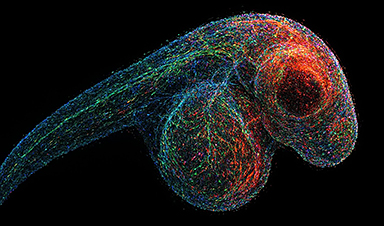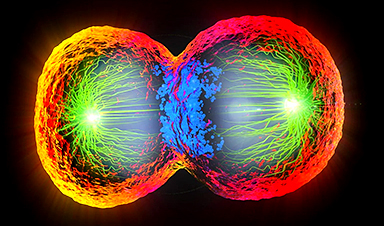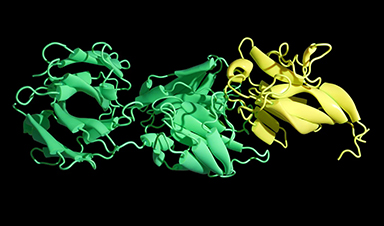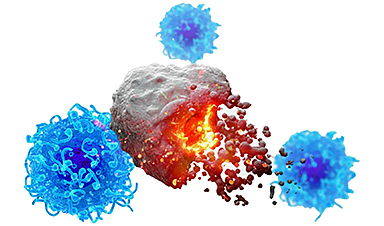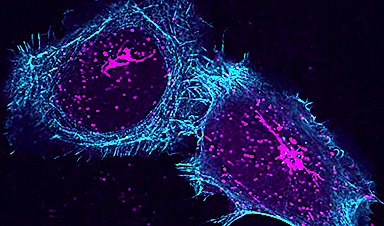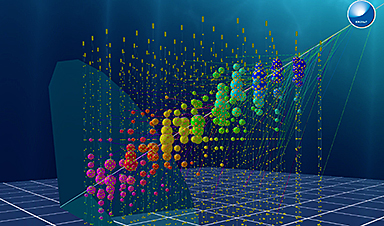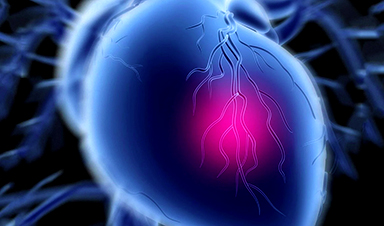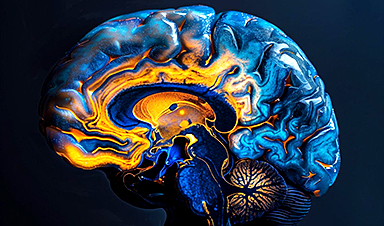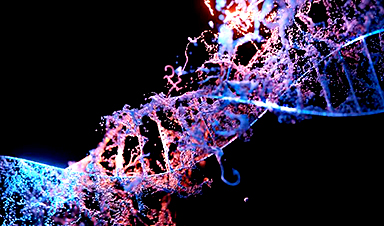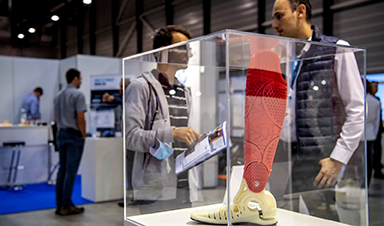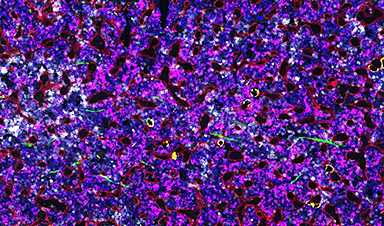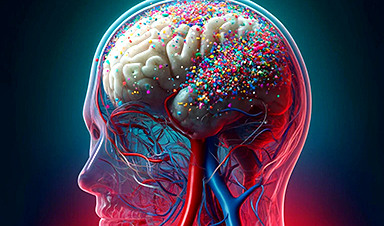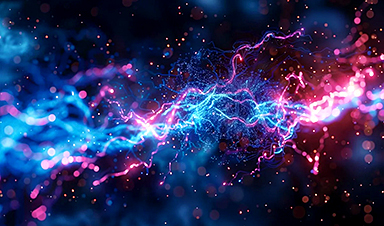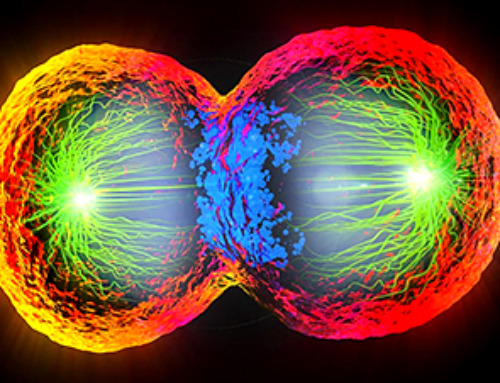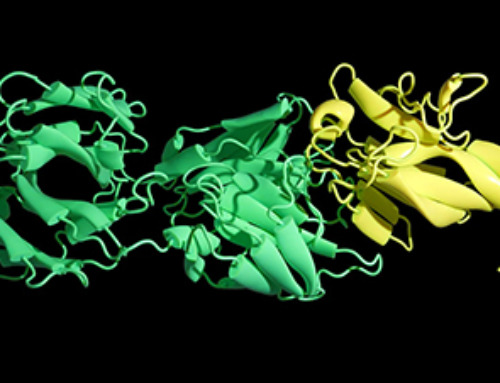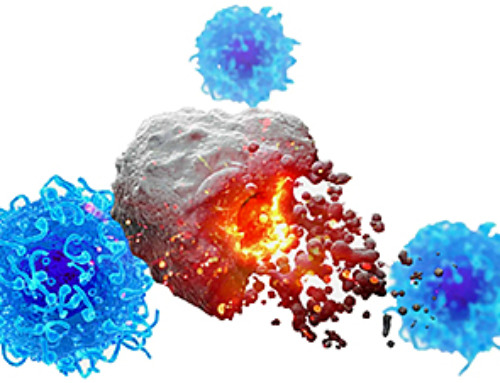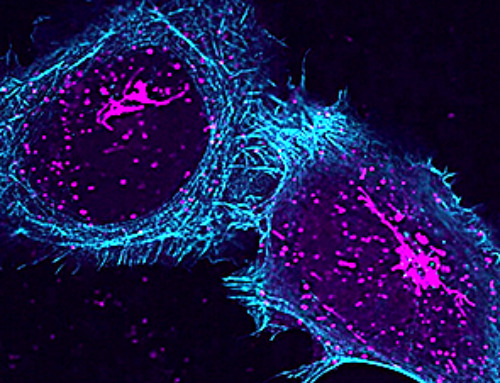| An international research team, led by scientists from the EMPA (Zurich) and the International Iberian Nanotechnology Laboratory, which has researchers from the UPV/EHU, has succeeded in building chains of quantum magnets made of nanographene that capture the essence of one of the core models of quantum magnetism. The team’s results (Nature, “Observation of fractional edge excitations in nanographene spin chains”) have implications for understanding quantum magnetism on the nanoscale and may open the door to building quantum computers. | |
| We are all used to the idea that simple units combine to form more complex structures. So atoms combine to form molecules, which in turn combine to form cells, and cells form tissue, ultimately giving rise to living beings. | |
| In the quantum world, this process may take place in reverse in such a way that the interaction between complex particles results in simpler particles. So, under certain circumstances, the interaction between electrons, indivisible particles with electric charge e, gives rise to the emergence of particles with charge e/3. This phenomenon is known as fractionalization. | |
Quantum magic: fractionalizing spins |
|
| All elementary particles have intrinsic properties such as mass or charge that are intuitive to us, and others such as spin, which can be visualised like a compass. However, unlike normal compasses, which can point in any direction, the spin of quantum systems is quantized, and can only assume a discrete set of values. For example, we say that the spin of an electron is ½ and can only take two values. Particles with spin 1 can take three values. | |
| In the 1980s the British physicist Duncan Haldane built a mathematical model for spin 1 particles in which the fractionalization of the spins took place. So when a one-dimensional chain of indivisible spin 1 particles interacted with their neighbours, they gave rise to the emergence of spin ½ particles on the edges of the chain. | |
| Like the magic trick in which the magician saws a person in half and pulls the two halves apart, the Haldane model allows spins 1 to be fractionalized and separated. It is one of the core models of quantum magnetism, and his work earned him the Nobel Prize in 2016. | |
One-dimensional chains of magnetic molecules assembled from graphene |
|
| Experimental confirmation of this prediction was challenging for various reasons, chief among them being the fact that one-dimensional materials do not exist. Indirect evidence of the phenomenon of spin fractionalization in organometallic materials containing chains of magnetic atoms existed, but direct observation remained elusive. | |
| Now, however, that observation has been made by an international team of researchers, including the Ikerbasque researcher David Jacob of the Department of Polymers and Advanced Materials: Physics, Chemistry and Technology at the UPV/EHU; he has collaborated in this work with the INL, the University of Alicante, the EMPA in Zurich and the University of Dresden. | |
| To accomplish this difficult feat, the researchers combined organic chemistry techniques with ultra-high vacuum surface science in order to synthesise graphene molecules with spin 1 that form unidimensional chains. Using a tunnelling microscope, the team of researchers were able to study, with atomic resolution, the quantum states of the chain adsorbed on a gold surface, compare them with those predicted by the theory, and establish that the system did in fact behave like the Haldane model. | |
| In particular, in chains with a sufficiently high number of magnetic molecules, the researchers found Kondo resonances at the tips of the chain, a phenomenon that occurs when spin ½ particles interact with the electrons in a conductor such as gold. From one-dimensional chains to two-dimensional networks and quantum computers | |
| The researchers say that this work “shows the potential for using nanographenes to form two-dimensional networks of nanomagnets, enabling predictions analogous to Haldane’s to be confirmed, such as, for example, the existence of quantum states that would allow quantum computation to be carried out”. |
News
DNA Microscopy Creates 3D Maps of Life From the Inside Out
What if you could take a picture of every gene inside a living organism—not with light, but with DNA itself? Scientists at the University of Chicago have pioneered a revolutionary imaging technique called volumetric DNA microscopy. It builds [...]
Scientists Just Captured the Stunning Process That Shapes Chromosomes
Scientists at EMBL have captured how human chromosomes fold into their signature rod shape during cell division, using a groundbreaking method called LoopTrace. By observing overlapping DNA loops forming in high resolution, they revealed that large [...]
Bird Flu Virus Is Mutating Fast – Scientists Say Our Vaccines May Not Be Enough
H5N1 influenza is evolving rapidly, weakening the effectiveness of existing antibodies and increasing its potential threat to humans. Scientists at UNC Charlotte and MIT used high-performance computational modeling to analyze thousands of viral protein-antibody interactions, revealing [...]
Revolutionary Cancer Vaccine Targets All Solid Tumors
The method triggers immune responses that inhibit melanoma, triple-negative breast cancer, lung carcinoma, and ovarian cancer. Cancer treatment vaccines have been in development since 2010, when the first was approved for prostate cancer, followed [...]
Scientists Uncover Hidden Protein Driving Autoimmune Attacks
Scientists have uncovered a critical piece of the puzzle in autoimmune diseases: a protein that helps release immune response molecules. By studying an ultra-rare condition, researchers identified ArfGAP2 as a key player in immune [...]
Mediterranean neutrino observatory sets new limits on quantum gravity
Quantum gravity is the missing link between general relativity and quantum mechanics, the yet-to-be-discovered key to a unified theory capable of explaining both the infinitely large and the infinitely small. The solution to this [...]
Challenging Previous Beliefs: Japanese Scientists Discover Hidden Protector of Heart
A Japanese research team found that the oxidized form of glutathione (GSSG) may protect heart tissue by modifying a key protein, potentially offering a novel therapeutic approach for ischemic heart failure. A new study [...]
Millions May Have Long COVID – So Why Can’t They Get Diagnosed?
Millions of people in England may be living with Long Covid without even realizing it. A large-scale analysis found that nearly 10% suspect they might have the condition but remain uncertain, often due to [...]
Researchers Reveal What Happens to Your Brain When You Don’t Get Enough Sleep
What if poor sleep was doing more than just making you tired? Researchers have discovered that disrupted sleep in older adults interferes with the brain’s ability to clean out waste, leading to memory problems [...]
How to prevent chronic inflammation from zombie-like cells that accumulate with age
In humans and other multicellular organisms, cells multiply. This defining feature allows embryos to grow into adulthood, and enables the healing of the many bumps, bruises and scrapes along the way. Certain factors can [...]
Breakthrough for long Covid patients who lost sense of smell
A breakthrough nasal surgery has restored the sense of smell for a dozen long Covid patients. Experts at University College London Hospitals NHS Foundation Trust successfully employed a technique typically used for correcting blocked nasal passages, [...]
Scientists Invent Plastic That Can Dissolve In Seawater In Just A Few Hours
Plastic waste and pollution in the sea have been among the most serious environmental problems for decades, causing immense damage to marine life and ecosystems. However, a breakthrough discovery may offer a game-changing solution. [...]
Muscles from the 3D printer
Swiss researchers have developed a method for printing artificial muscles out of silicone. In the future, these could be used on both humans and robots. Swiss researchers have succeeded in printing artificial muscles out [...]
Beneficial genetic changes observed in regular blood donors
Researchers at the Francis Crick Institute have identified genetic changes in blood stem cells from frequent blood donors that support the production of new, non-cancerous cells. Understanding the differences in the mutations that accumulate [...]
Shocking Amounts of Microplastics in the Brain – It Could Be Increasing Our Risk of Dementia
The brain has higher concentrations of plastic particles compared to other organs, with increased levels found in dementia patients. In a comprehensive commentary published in Brain Medicine, researchers highlight alarming new evidence of microplastic accumulation [...]
Baffling Scientists for Centuries: New Study Unravels Mystery of Static Electricity
ISTA physicists demonstrate that contact electrification depends on the contact history of materials. For centuries, static electricity has intrigued and perplexed scientists. Now, researchers from the Waitukaitis group at the Institute of Science and [...]

